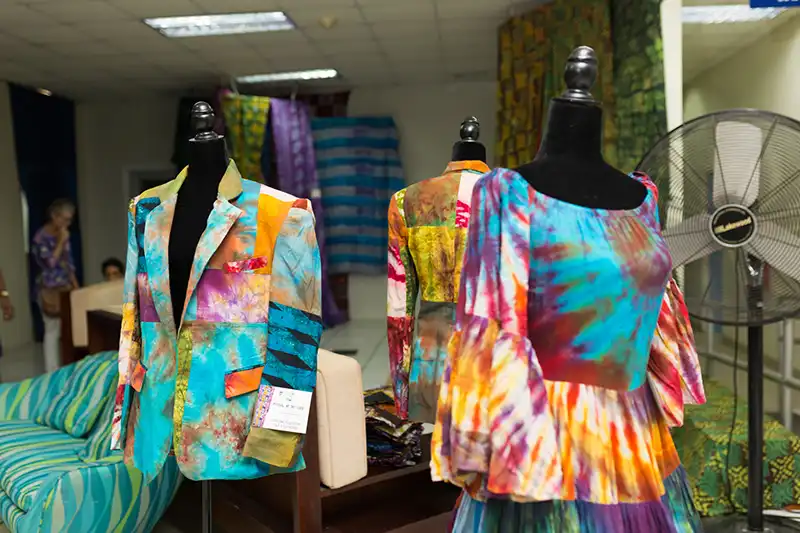Our African heritage is more than just the colour of our skin. It is how we Jamaicans rise above our struggles, turning tears into a culture of resilience, one that is represented by the JADIRE. From a plain piece of fabric to a work of art. Each colour standing in its glory. Each pattern telling a story – The “JADIRE” story.
Alao Luqman Omotayo, a Nigerian diplomat who has been with JBDC for over 5 years and is the pioneer for JADIRE says, “It is a combination of Jamaica and the Yoruba word Adire. Adire is an indigo dyed cloth made from southwest Nigeria by Yoruba women using a variety of resist dyeing technique.”

The beauty is in the technique. Among the techniques are adire eleko (starch resist), adire oniko (tie and dye), adire alabere (stitching method), adire onipatan (silk or batik painting) and adire alabele (candle wax).
Using the Adire alabele technique, the Entrepreneur Weekly will give you a step-by-step guide for making your very own ‘JADIRE’.
Before we go into the process, you will need:
- White fabric that is 100 percent cotton
- Fabric dye in colours of your choice; reactive dye is perfect for this process
- Table
- Gloves
- paraffin wax
- Tubs large enough to hold cloth
- Marker
- Clothes iron
- Stencil knife
- Heat source
- Pot
- Chemicals such as carbamide (urea), sodium carbonate (soda ash) and table salt
- 3x3x2, 4x4x4 or 5x7x4 sponge
Now let’s get started!
Step 1 – Prepare for dyeing
Wash cloth to remove starch that may be on fabric. Hang cloth to dry. Then iron fabric. Use permanent marker to create shape on sponge. Use stencil knife to cut out shape no deeper than one inch into sponge. This shape will help to create your pattern.
Step 2 – Creating the Perfect Pattern
Spread ironed cloth across the table. Ensure that the cloth is flat. Melt paraffin wax to 250 – 270 degrees celsius. Dip sponge into melted wax. Stamp cloth on desired areas with sponge to create pattern. Wax will resist the dye in the areas it is stamped.
Step 3 – Dyeing
Pour hot water into four measuring cups. Dissolve 2 teaspoons of dye to first cup, 4 teaspoons of carbamide (urea) to the other cup, 8 teaspoons of table salt to the third cup and do the same with 6 table spoons of soda ash (sodium carbonate).
Place stamped fabric into tub of room temperature water with dye, salt and urea solution. After 10 minutes, add sodium carbonate (soda ash) to the water. Leave fabric for 40 – 45 minutes. Ensure that fabric is completely immersed into the water. Remove fabric from hot water. Hang fabric to dry for 20 minutes. The fabric does not have to be completely dried.
Step 4 – Dewaxing
Add water to pot and boil to 100 degrees Celsius. In a separate tub, pour room temperature water. Dip fabric into pot with boiling water, stir the fabric for about 10 seconds. Remove fabric and add to tub with cold water immediately to separate wax from fabric. Repeat dipping fabric to cold water the wax is separated from fabric. Hang to dry.
Now you have a unique piece of fabric that you can turn into fashion that only you will show up to that function wearing!

The Making of Jadire Fashion
Robert Hall, Fashion Expert at the JBDC Incubator & Resource Centre says that the Jadire can be transformed into trendy Jamaican pieces that connect people to their African roots, “There is that kind of personal responsibility that people take to build out their personal brand and present themselves and so whether male or female, people are invested into bringing out images that are original and different. The fabric offers that opportunity to bring about cultural awareness adding to a woke sensibility or just like someone who is grounded or aware of who they are.”
The Jadire is patterned with Jamaican cultural symbols ranging from the ackee to Rastafarian artefacts. Each pattern telling the Jamaican story. The fabric epitomises the African Jamaican culture through its storytelling and versatility. We are a very creative people and we are into doing our own thing. Jamaicans don’t like to do the same thing like others. The Jadire gives us this opportunity to be different.
Fashion pieces that have been manufactured from Jadire include male apparel such as pants, shorts, shirts, jackets, and sandals. Designers have also created dresses, tote bags, clutch bags and earrings for women.

100 Jadire Artisans Trained
The Jadire programme is an initiative between the JBDC and the Nigerian High Commission to transfer a valuable piece of history to Jamaica. Since 2019, the JBDC has trained just over one hundred (100) persons at the IRC. These include a group from the Ethiopian Orthodox Church. “We have been planting the seeds and we want persons to realise the value of Jadire. Several artisans who benefitted from the training have commercialised,” says Colin Porter, Technical Services Manager at the JBDC. The Jadire Programme is ongoing and interested persons can be trained.
The JBDC is encouraging small and large-scale production of batik/ tie dye for domestic uses and exportation, as well as to promote the use of Jamaican fabrics with Jamaican pattern/motifs. This will enhance the creative Micro, Small & Medium-sized Enterprise (MSME) sector and entrepreneurship, particularly among designers and producers of fashion, textiles and accessories.

The Fashion Incubator
The fashion incubator is available to designers who have a need for small manufacturing cells to satisfy demand for their products. Within the facility are several cells of industrial straight stitch and serger machines. Additionally, there are other specialised machines such as cover stitch, button hole and button tack machines are also available. The space also provides use of a cutting table, steam pressing and other auxiliary services and is able to accommodate multiple users simultaneously. JBDC will take you from creating your Jadire design to getting market-ready. Get started here https://www.jbdc.net/services/technical-services/.










